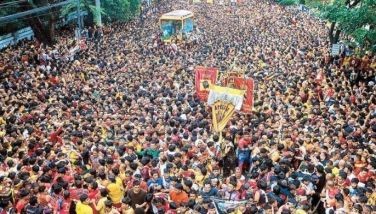CL aggie, fishery losses reach P.36 B
August 4, 2006 | 12:00am
SAN FERNANDO, Pampanga — What typhoon "Glenda" had spared, tropical depression "Henry" apparently finished off in Central Luzon as it left an estimated P361 million in agricultural and fishery losses.
"The (palay) crops that survived ‘Glenda’ were finally destroyed by floods caused by ‘Henry.’ Palay crops cannot be salvaged if they remain inundated for three days," Redentor Gatus, assistant regional director of the Department of Agriculture (DA), told The STAR.
According to the DA, palay and vegetable crop losses across the region were placed at P235 million, while the fisheries sector in Bataan, Bulacan, Pampanga, and Zambales lost about P126 million.
Gatus said at least 25,000 rice farmers and another 2,500 vegetable farmers in Central Luzon were affected by the floods spawned by the two recent weather disturbances.
Quoting reports reaching his office, Gatus said the floods left to waste an estimated 58,747 metric tons of palay crops planted in 60,048 hectares throughout the region.
He said only the crops in about 20,000 hectares can still be salvaged.
Pampanga bore the brunt of "Glenda" and "Henry," with palay losses placed at P58 million, followed by Tarlac, P38 million; Nueva Ecija, P27 million; Bulacan, P18 million; Zambales, P15 million; Bataan, P6 million; and Aurora, P600,000.
Marian Fernando, DA’s high-value crops coordinator in Bulacan, said the province suffered the biggest losses in the vegetable sector, placed at P70 million.
Floods washed away some 15,000 cavans of vegetable seedlings and destroyed vegetable farms in the Bulacan towns of Baliaug, San Miguel, San Ildefonso, San Rafael, Sta. Maria, and Bulacan, and Malolos City, she said.
Among these towns, Fernando said San Ildefonso suffered the most, with vegetable farm losses reaching about P40 million. Some 2,500 vegetable farmers in the town, who usually earned P20,000 for every 1,000 square meters every three months, were affected.
"Many of the farmers in the rainfed vegetable farms in San Ildefonso, San Rafael, and San Miguel have become millionaires, but they are not going to earn as much this year because of the floods," Gatus said.
Citing partial reports, Stephen Arlo Lapid of the Bureau of Fisheries and Aquatic Resources’ planning office, said raisers of prawns, tilapia, milkfish and other common fishpond fish in 13 towns in Pampanga, eight in Bulacan, four in Bataan, and three in Zambales suffered about P125 million in losses due to the floods.
Pampanga incurred the biggest fishery losses at P112 million, followed by Bulacan, P8.8 million; Bataan, P2.6 million; and Zambales, P1.1 million.
Meanwhile, residents of Calumpit, Bulacan were told to brace for prolonged flooding as floodwaters from Tarlac, Nueva Ecija and Pampanga drain into Manila Bay.
The same is true in Hagonoy town, where floodwaters from upper Central Luzon find their way before flowing out to Manila Bay. — With Ric Sapnu and Dino Balabo
"The (palay) crops that survived ‘Glenda’ were finally destroyed by floods caused by ‘Henry.’ Palay crops cannot be salvaged if they remain inundated for three days," Redentor Gatus, assistant regional director of the Department of Agriculture (DA), told The STAR.
According to the DA, palay and vegetable crop losses across the region were placed at P235 million, while the fisheries sector in Bataan, Bulacan, Pampanga, and Zambales lost about P126 million.
Gatus said at least 25,000 rice farmers and another 2,500 vegetable farmers in Central Luzon were affected by the floods spawned by the two recent weather disturbances.
Quoting reports reaching his office, Gatus said the floods left to waste an estimated 58,747 metric tons of palay crops planted in 60,048 hectares throughout the region.
He said only the crops in about 20,000 hectares can still be salvaged.
Pampanga bore the brunt of "Glenda" and "Henry," with palay losses placed at P58 million, followed by Tarlac, P38 million; Nueva Ecija, P27 million; Bulacan, P18 million; Zambales, P15 million; Bataan, P6 million; and Aurora, P600,000.
Marian Fernando, DA’s high-value crops coordinator in Bulacan, said the province suffered the biggest losses in the vegetable sector, placed at P70 million.
Floods washed away some 15,000 cavans of vegetable seedlings and destroyed vegetable farms in the Bulacan towns of Baliaug, San Miguel, San Ildefonso, San Rafael, Sta. Maria, and Bulacan, and Malolos City, she said.
Among these towns, Fernando said San Ildefonso suffered the most, with vegetable farm losses reaching about P40 million. Some 2,500 vegetable farmers in the town, who usually earned P20,000 for every 1,000 square meters every three months, were affected.
"Many of the farmers in the rainfed vegetable farms in San Ildefonso, San Rafael, and San Miguel have become millionaires, but they are not going to earn as much this year because of the floods," Gatus said.
Citing partial reports, Stephen Arlo Lapid of the Bureau of Fisheries and Aquatic Resources’ planning office, said raisers of prawns, tilapia, milkfish and other common fishpond fish in 13 towns in Pampanga, eight in Bulacan, four in Bataan, and three in Zambales suffered about P125 million in losses due to the floods.
Pampanga incurred the biggest fishery losses at P112 million, followed by Bulacan, P8.8 million; Bataan, P2.6 million; and Zambales, P1.1 million.
Meanwhile, residents of Calumpit, Bulacan were told to brace for prolonged flooding as floodwaters from Tarlac, Nueva Ecija and Pampanga drain into Manila Bay.
The same is true in Hagonoy town, where floodwaters from upper Central Luzon find their way before flowing out to Manila Bay. — With Ric Sapnu and Dino Balabo
BrandSpace Articles
<
>
- Latest
- Trending
Trending
Latest
Trending
Latest
Recommended
January 10, 2025 - 12:00am





























